Installation: Gigabyte Gaming Monitor M27Q P User Guide

Content
Introduction
The Gigabyte Gaming Monitor M27Q P is a cutting-edge 27-inch display designed for gamers seeking high performance and vibrant visuals. Featuring a QHD resolution (2560 x 1440) and an impressive refresh rate of 165Hz (overclockable to 170Hz), this monitor ensures fluid gameplay and sharp image quality. With its IPS panel, it delivers a wide color gamut and fast response time of just 1ms, making it ideal for competitive gaming. The M27Q P is priced at approximately $399.99.
Unpacking
- Open the upper cover of the packaging box. Then observe the unpacking label attached on the inner cover.
Making sure the box is in the correct orientation, carefully lay the box on the stable surface.
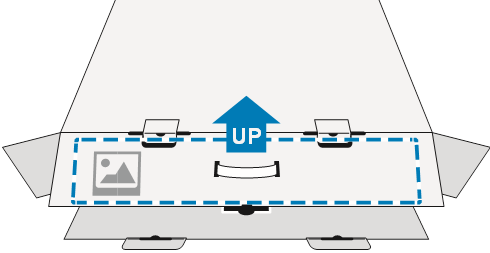
Open the inner cover.
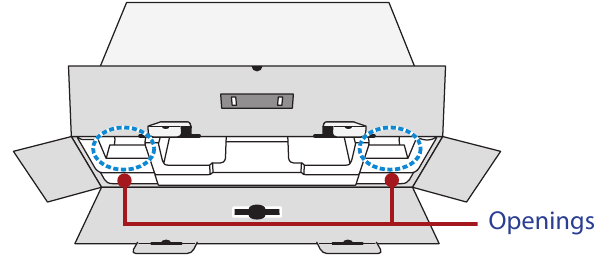
Grab the EPS foam assembly (through the openings) to pull it out of the box.
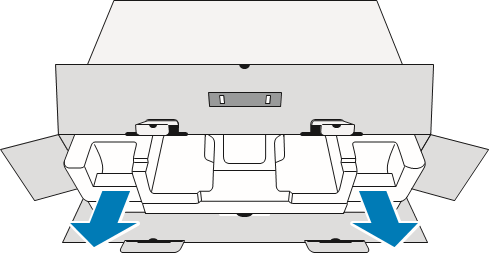
Remove the items from the upper EPS foam.
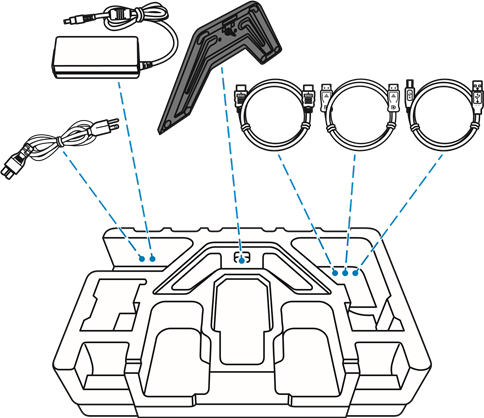
Remove the upper EPS foam. Then you can remove the monitor from the lower EPS foam.
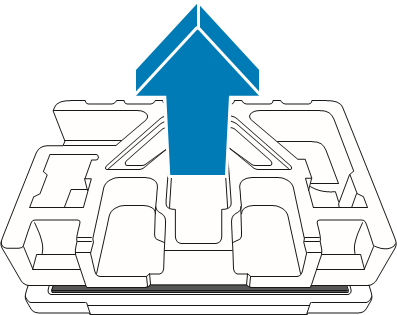
Package Contents
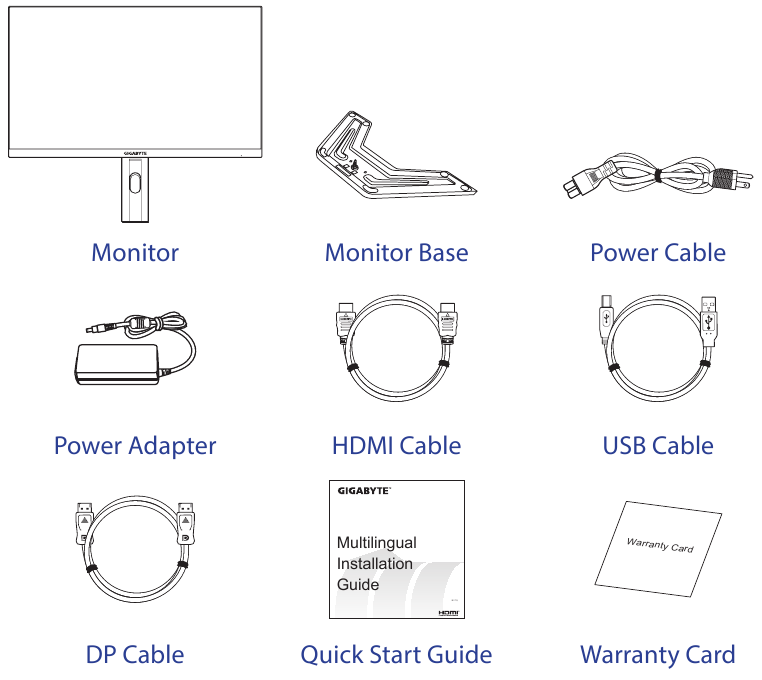
Note: Please keep the packaging box and packing materials for future transportation of the monitor.
Product Overview
Front View
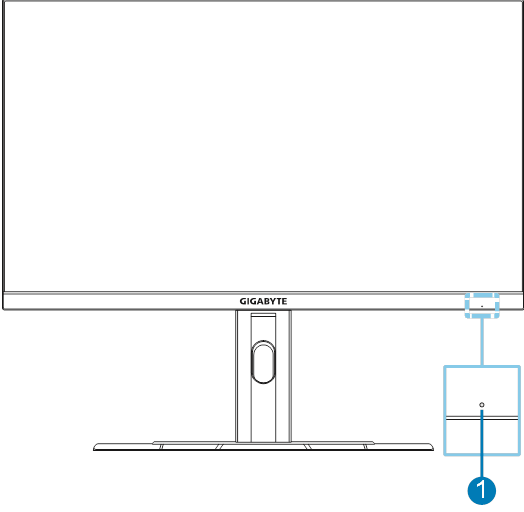
- Power LED
Rear View
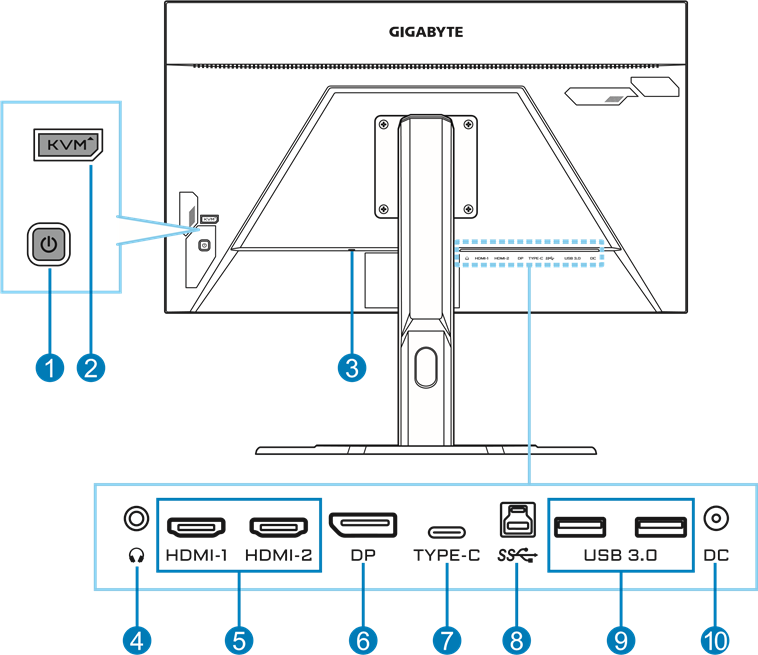
- Control button
- KVM button
- Kensington lock
- Headphone jack
- HDMI ports (x2)
- DisplayPort
- USB Type-C port
- USB upstream port
- USB 3.0 ports (x2)
- DC IN jack
Gigabyte Gaming Monitor M27Q P Specifications
| Item | Specifications |
| Panel Size | 27-inch |
| Aspect Ratio | 16:9 |
| Resolution | 2560 x 1440 |
| Refresh Rate | 170Hz |
| LED Life | 30,000 hours |
| Pixel Pitch | 0.2331 x 0.2331 |
| Response Time | 0.5ms (MPRT) |
| Brightness | 350nits (typ.) |
| Contrast Ratio | 1000:1 (typ.) |
| Dynamic Contrast Ratio | 12M:1 (typ.) |
| Color Depth | 16.7M |
| Active Display Area | 596.736 (H) x 335.664 (V) |
| Viewing Angle | 178°(H) / 178°(V) |
| Frequency | 170Hz |
| Input/Output Terminals |
|
| Power Supply | AC 100~240V at 50/60Hz |
| AC Adapter Model | Asian Power Devices Inc. DA-65C19 Dongguan Yingju Power Co., Ltd. YJS065I-1903420D |
| Power Consumptions |
|
| Dimensions (W x H x D) | 615.1 x 533.6 x 202.97 mm (with stand) |
| Weight |
|
| Temperature Range (operation) | 0°C to 40°C |
Note: Specifications subject to change without notice.
Description
The Gigabyte M27Q P is engineered with gamers in mind, offering a combination of high-performance features and aesthetic appeal. The VA panel provides vibrant colors and deep blacks, while the 165Hz refresh rate and 0.5ms response time ensure smooth and responsive gameplay. The monitor's ergonomic design allows for height, tilt, and swivel adjustments, ensuring maximum comfort during extended gaming sessions.
The monitor also features a sleek and minimalist design, making it a stylish addition to any gaming setup. With its robust connectivity options, including HDMI 2.0 and DisplayPort 1.4, users can easily connect their gaming consoles, PCs, or other devices.
GETTING STARTED
Installing the Monitor Base
- Place the monitor on the lower EPS foam, with the screen facing down.
Align the monitor base with the standoff underneath the stand. Then attach the base onto the stand.
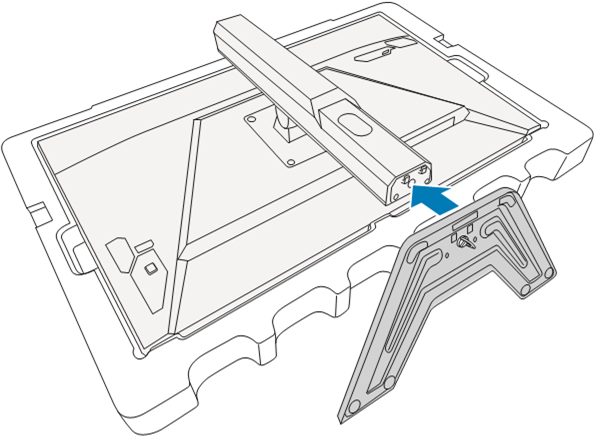
Lift the screw ring and turn it clockwise to secure the monitor base in place.

- Lift the monitor to an upright position and place it on a table.
Remove the small block of EPS foam located in between the rear of the screen and the stand. Then remove the safety plate from its slot.
Note: By removing the safety plate, you can now adjust the screen to the desired height.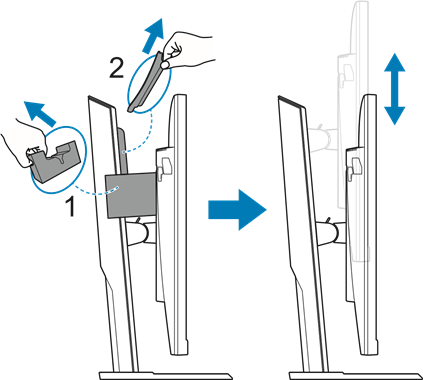
Adjusting the Viewing Angle
Note: Hold the monitor base so that the screen does not topple when you make the adjustment.
Adjusting the Tilt Angle
Tilt the screen forward or backward to the desired viewing angle (5˚ to 20˚).
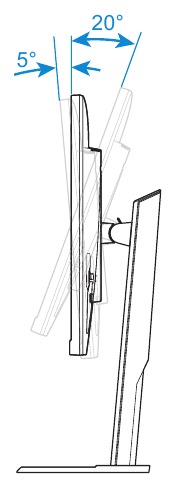
Adjusting the Screen Height
Lower or raise the screen to the desired height (0 to 130mm).
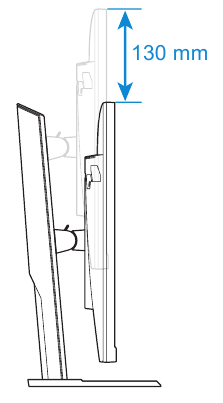
Installing a Wall-Mount Bracket (Optional)
Use only the 100 x 100 mm wall mount kit recommended by the manufacturer.
- Place the monitor on the lower EPS foam, with the screen facing down.
Remove the screws securing the stand to the monitor.
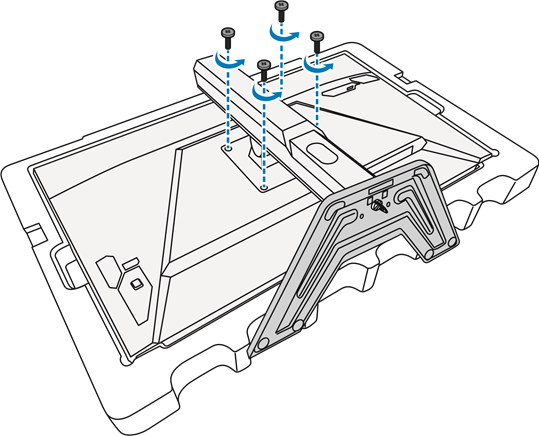
Remove the stand.
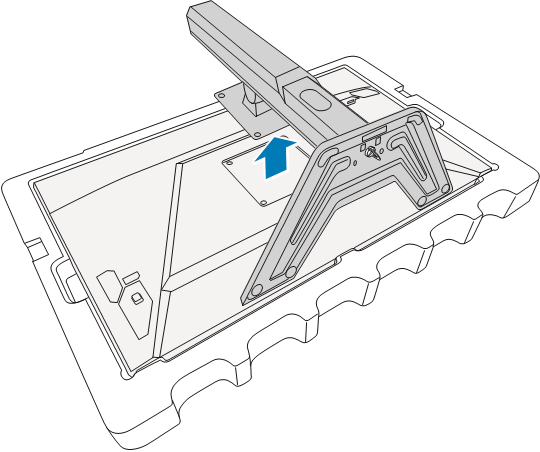
Attach the mounting bracket to the mounting holes at the rear of the monitor. Then use the screws to secure the bracket in place.
Note: To mount the monitor on the wall, refer to the installation guide that is included in the wall-mount bracket kit.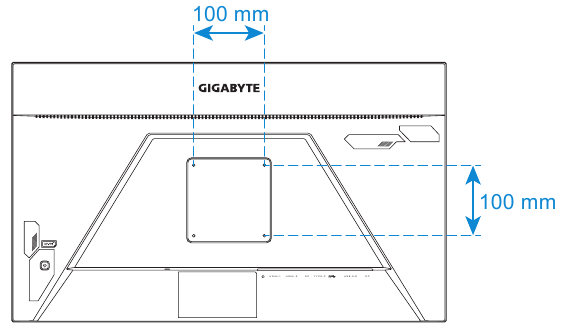
Making Connections
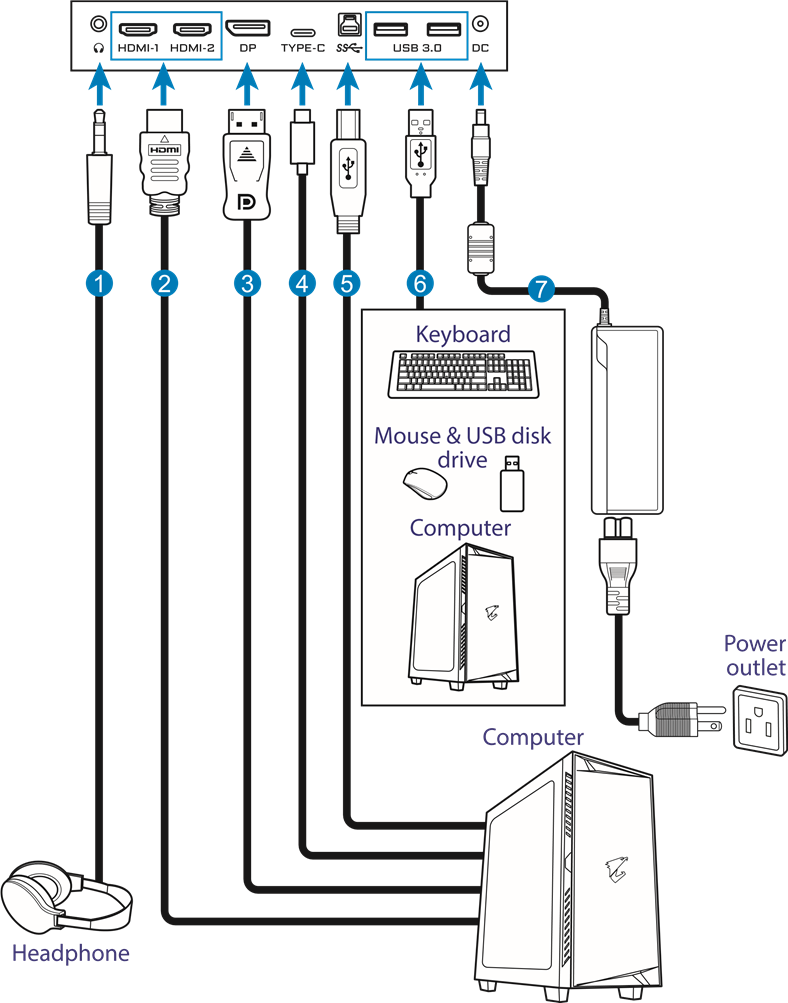
- Headphone cable
- HDMI cable
- DisplayPort cable
- USB Type-C cable
- USB (A-Male to B-Male) cable
- USB cable
- Power adapter and power cable
USING THE DEVICE
Turning the Power On/Off
Power On
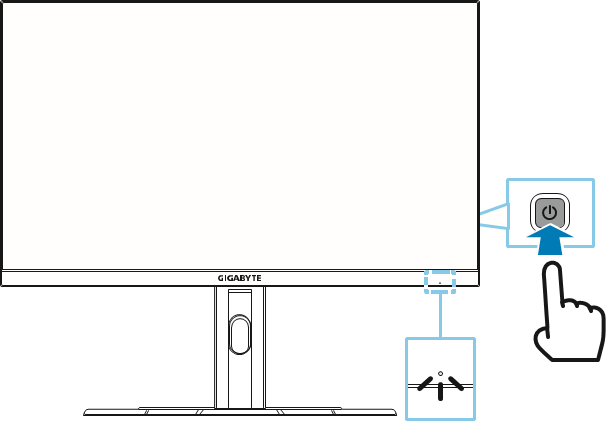
- Connect the power cable to the power adapter.
- Connect the power adapter to the DC IN jack at the rear of the monitor.
- Connect the power cable to a power outlet.
- Press the Control button to turn on the monitor. The Power LED will light in white, indicating the monitor is ready to use.
Note: If no signal, the monitor will show No Signal notification for a while. Then, the monitor will go to power saving mode and the Power LED lights white and starts blinking with a period of one second.
Power Off
Press the Control button for 2 seconds to turn off the monitor. Note: When the Main menu appears on the screen, you can also turn off the monitor by moving the Control button down ![]() .
.
User Comfort Recommendations
The following are some tips for comfortable viewing of your monitor:
- Optimal viewing distances for monitors range from approximately 510 mm to 760 mm (20" to 30").
- A general guideline is to position the monitor such that the top of the screen is at or slightly below your eye-height when you are comfortably seated.
- Use adequate lighting for the type of work you are performing.
- Take regular and frequent breaks (at least for 10 minutes) every halfhour.
- Be sure to periodically look away from your monitor screen and focus on a far object for at least 20 seconds during the breaks.
- Eye exercise can help reduce eye strain. Repeat these exercises frequently:
- look up and down
- slowly roll your eye
- move your eyes diagonally.
Selecting the Input Source
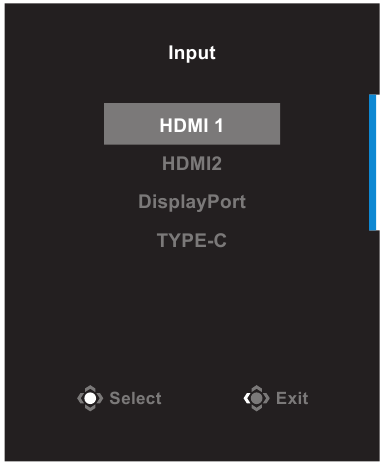
- Move the Control button right (
 ) to enter the Input menu.
) to enter the Input menu. - Move the Control button up/ down (
 ) to select the desired input source. Then press the Control button to confirm.
) to select the desired input source. Then press the Control button to confirm.
OPERATIONS
Quick Menu
Hot Key
By default, the Control button has been assigned with the specific function.
Note: To change the preset hot key function, refer to the "Quick Switch" section.
To access the hot key function, do the following:
Move the Control button up (
 ) to enter the Black Equalizer menu.
) to enter the Black Equalizer menu.
Move the Control button up/down ( ) to adjust the setting and press the Control button to confirm.
) to adjust the setting and press the Control button to confirm.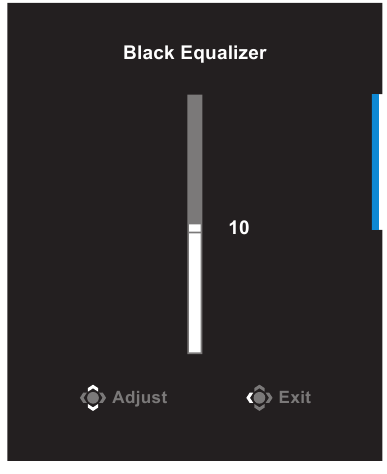
Move the Control button down (
 ) to enter the Picture Mode menu.
) to enter the Picture Mode menu.
Move the Control button up/down ( ) to select the desired option and press the Control button to confirm.
) to select the desired option and press the Control button to confirm.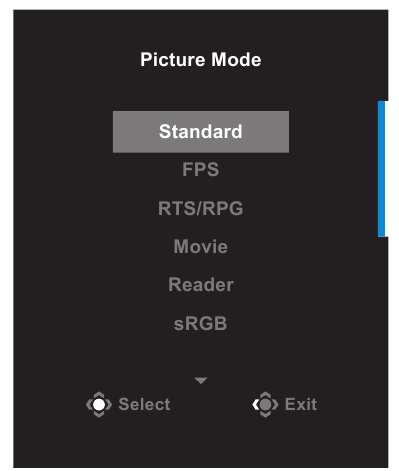
Move the Control button left (
 ) to enter the Volume menu. Move the Control button up/down (
) to enter the Volume menu. Move the Control button up/down ( ) to adjust the headphone volume level and press the Control button to confirm.
) to adjust the headphone volume level and press the Control button to confirm.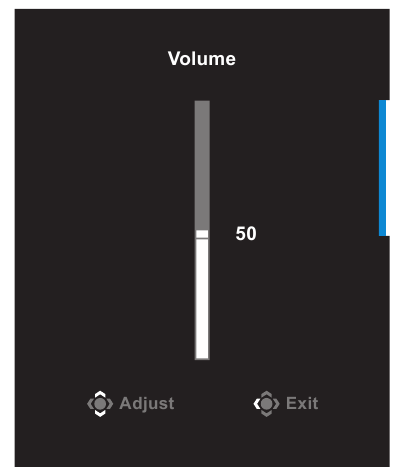
- Move the Control button right (
 ) to enter the the Input menu.
) to enter the the Input menu.
Refer to the "Selecting the Input Source" section.
Note: To close the menu, move the Control button left ( ).
).
Function Key Guide
Press the Control button to display the Main menu.
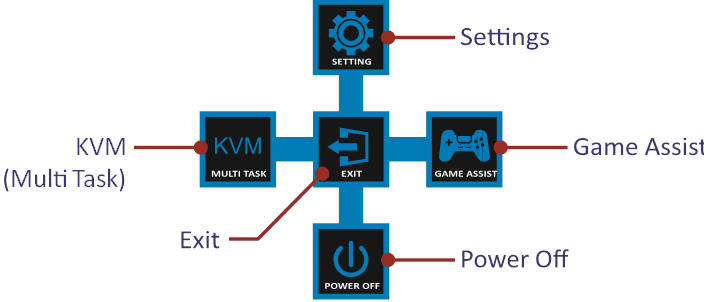
Then use the Control button to select the desired function and configure the related settings.
KVM
When the Main menu appears on the screen, move the Control button left (![]() ) to enter the KVM menu.
) to enter the KVM menu.
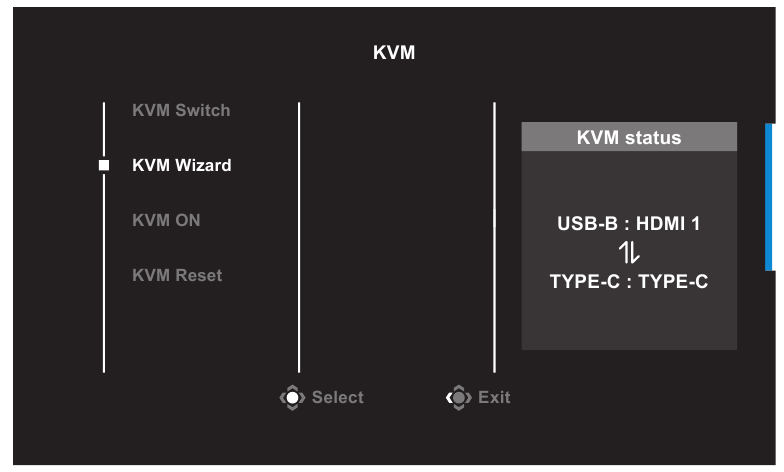
KVM Switch: Switch the input source that has been assigned to USB-B or Type-C connection in the KVM Wizard settings.
When there are several input signals connected to the device, a message box will appear on the screen once the system detected USB Type-C input signal.
To switch to USB Type-C input source, simply press the KVM button or the Control button.
However, when there is no input signal from currently selected input source, the system will return to the previous connected input source.
Note: This option will be disabled if the KVM button function is disabled (KVM OFF).
KVM Wizard: Configure the KVM related settings.
Set the input source to be bound with USB Type-B connection first, and then following with USB Type-C connection.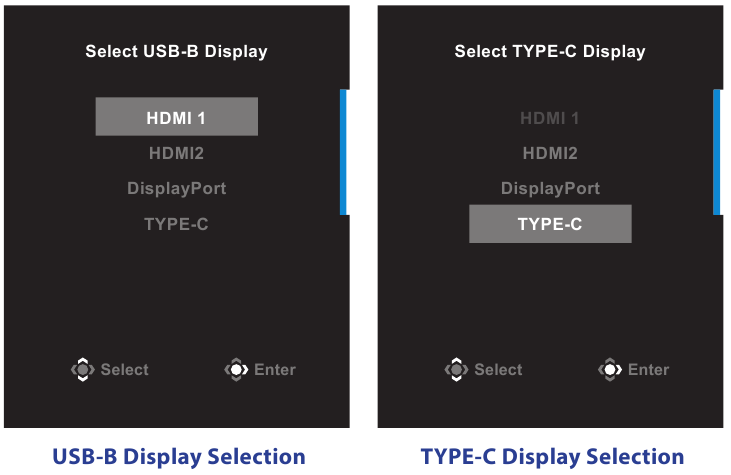
Note: If you set the USB-B Display setting to TYPE-C, the TYPE-C Display menu option will automatically be disabled. You will then see the KVM status in the KVM Wizard page as below.
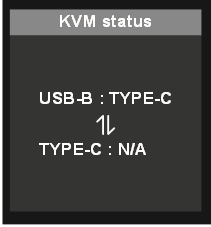
KVM ON/OFF: Enable/Disable the KVM button function.
- Select ON to enable the KVM button function. Once the system detected USB Type-C input signal, a message box will appear on the screen.

Press the KVM button or the Control button to switch to USB Type-C input source.
Note: When the KVM button function is enabled, the KVM ON will be displayed on the left panel.- Select OFF to disable the KVM button function.
Note: When the KVM button function is disabled, the KVM OFF will be displayed on the left panel.
- KVM Reset: Restore the KVM default settings.
- HDMI 1 input source is bound with USB Type-B connection.
- USB Type-C input source is bound with USB Type-C connection.
- The KVM ON/OFF function is set to ON.
Game Assist
When the Main menu appears on the screen, move the Control button right (![]() ) to enter the Game Assist menu.
) to enter the Game Assist menu.
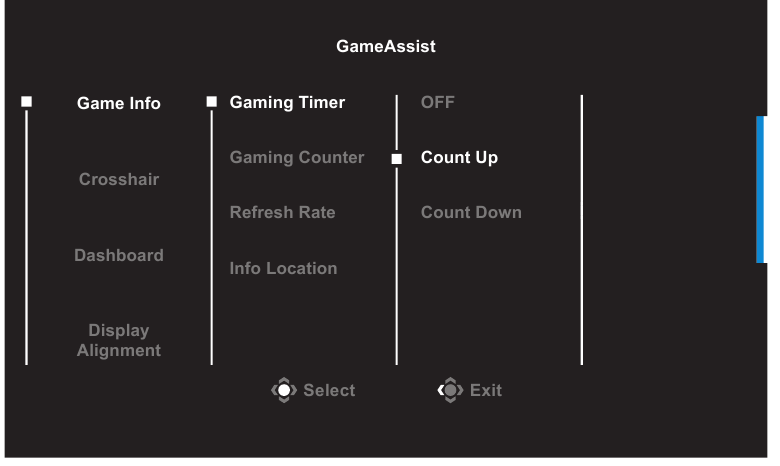
- Game Info: Configure the FPS (First Person Shooting) game related settings.
- Select Gaming Timer to select countdown timer mode. To disable this function, set the setting to OFF.
- Select Gaming Counter or Refresh Rate to enable/disable the gaming counter or real-time refresh rate setting.
Select Info Location to specify the location of the information to be shown on the screen.
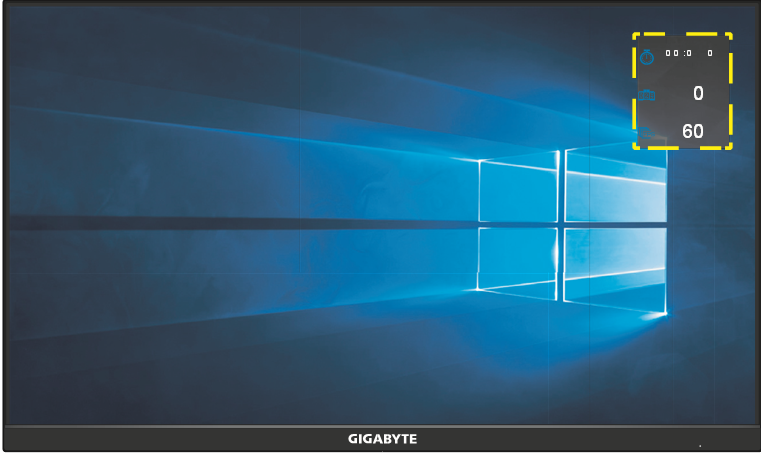
- Crosshair: Select the desired crosshair type to suit your gaming environment. It makes aiming much easier.
Dashboard: Configure the dashboard settings.
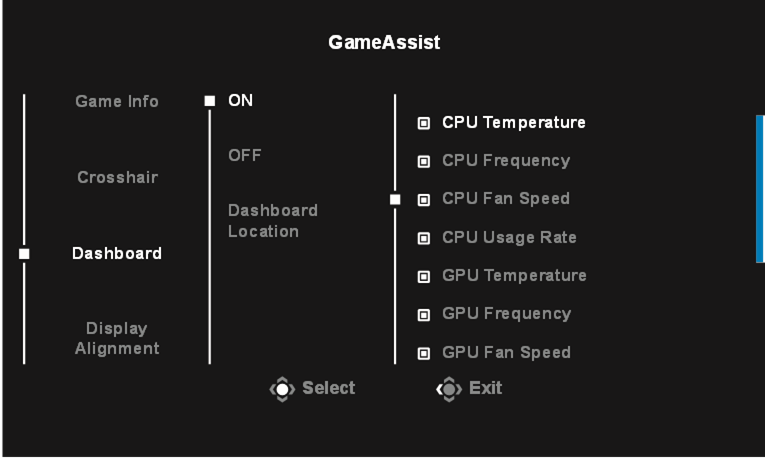
- ON: Enable the function. Then select the desired option(s) to be shown on the screen.
- OFF: Disable the function.
Dashboard Location: Specify the location of the Dashboard information to be shown on the screen. Once the Dashboard configuration is complete, it will transfer the system data to the SOC through the USB port and display the value of the selected function(s) on the screen.
Note: Make sure the USB cable is properly connected to the USB upstream port of the monitor and the USB port of your computer.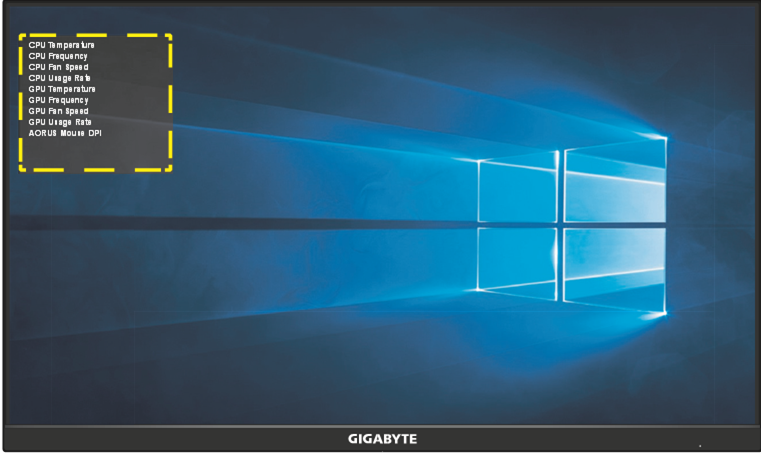
- Display Alignment: When the function is enabled, it displays the alignment lines on the four sides of the screen, providing handy tool for you to line up multiple monitors perfectly.
Configure the Device Settings
When the Main menu appears on the screen, move the Control button up (![]() ) to enter the Settings menu.
) to enter the Settings menu.
Note: Use the Control button to navigate through the menu and make adjustments.
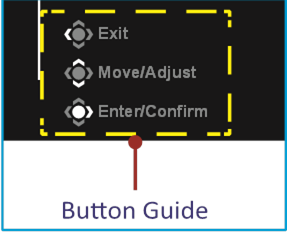
Gaming
Configure the game related settings.
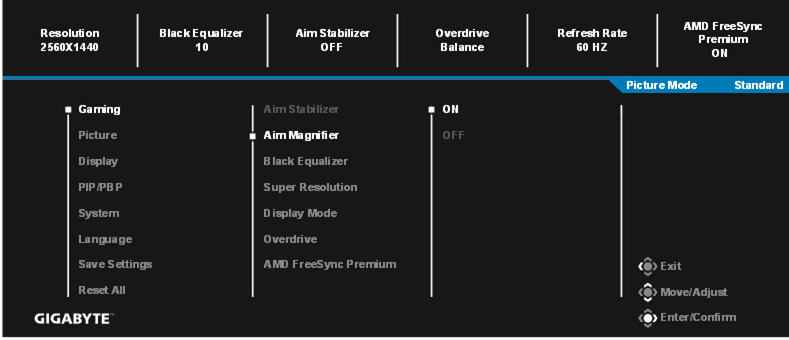
| Item | Description |
| Aim Stabilizer | When this function is enabled, it reduces the motion blur in a fast moving games.
|
| Aim Magnifier | When this function is enabled, it will enlarge the middle of screen. |
| Black Equalizer | Adjust the brightness of the black areas. |
| Super Resolution | Sharpen the low resolution images. |
| Display Mode | Select the aspect ratio of the screen.
Note: 1:1, 22"W(16:10), 23"W(16:9), 23.6W"(16:9), and 24"W(16:9) options will be disabled when the AMD FreeSync Premium function is activated. |
| Overdrive | Improve the response time of the LCD monitor. |
| AMD FreeSync Premium | When this function is enabled, it eliminates the screen lag and tearing while playing games. |
Picture
Configure the image related settings.
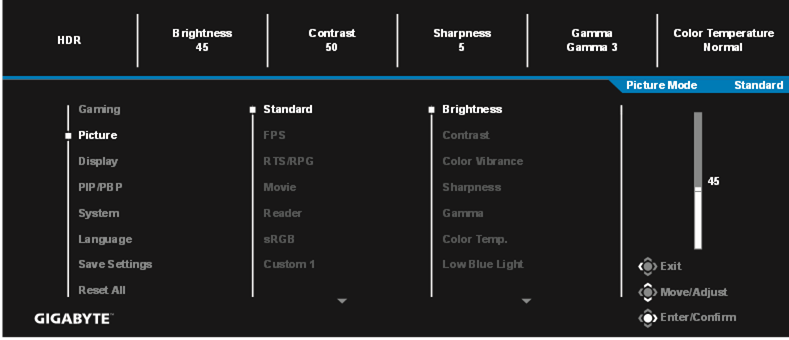
Select the one of the preset picture mode.
- Standard: For editing documents or browsing websites.
- FPS: For playing FPS (First Person Shooting) games.
- RTS/RPG: For playing RTS (Real-Time Strategy) or RPG (Role-Playing Game) games.
- Movie: For watching movies.
- Reader: For viewing documents.
- sRGB: For viewing photos and graphics on the computer.
- Custom 1: Customized picture mode settings.
- Custom 2: Customized picture mode settings.
- Custom 3: Customized picture mode settings.
Then you can configure the following image settings.
| Item | Description |
| Brightness | Adjust the brightness of the image. |
| Contrast | Adjust the contrast of the image. |
| Color Vibrance | Adjust the intensity of the more muted colors. |
| Sharpness | Adjust the sharpness of the image. |
| Gamma | Adjust the middle level of luminance. |
| Color Temperature | Select the color temperature. Note: Select User Define to customize the color temperature by adjusting the red (R), green (G), or blue (B) level according to your preference. |
| Low Blue Light | Reduce the amount of blue light exposure from the screen.
Note: Level 10 is optimized setting. It is compliance with TUV Low Blue Light Certification. |
| DCR | Adjust the black level of the image to achieve the optimum contrast. |
| Senseye Demo | Split the screen in half (2 windows). The image of the selected mode with its default settings will appear on the left window and the adjusted image with the new settings will appear on the right window. |
| Reset Picture | Reset all Picture settings to the default settings. |
Display
Configure the display screen related settings.
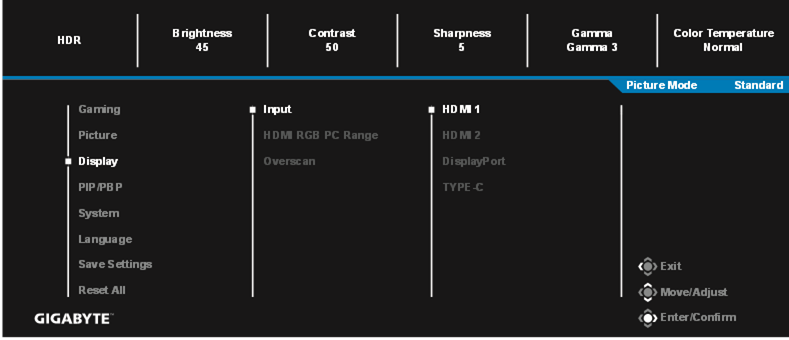
| Item | Description |
| Input | Select the input source. |
| HDMI RGB PC Range | Select an appropriate RGB range setting or let the monitor to detect it automatically. Note: This option is only available for HDMI input. |
| Overscan | When this function is enabled, it slightly enlarges the input image to hide the outermost edges of the image. Note: This option is only available for HDMI input. |
PIP/PBP
Configure the multi-picture-related settings.
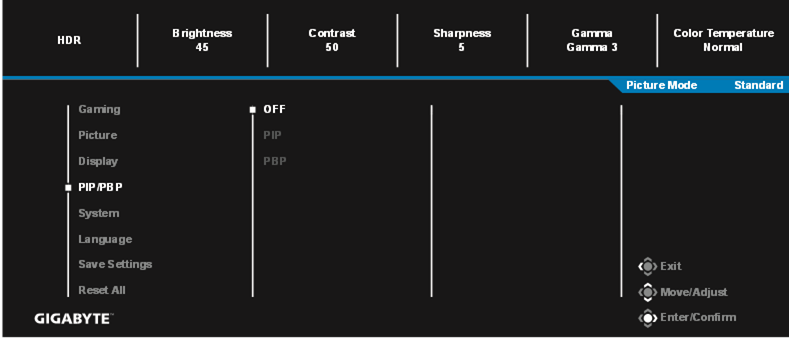
| Item | Description |
| OFF | Disable the PIP/PBP function. |
| PIP | Split the screen into 2 parts (main window and inset window).
|
| PBP | Display 1x1 split screen (left and right windows).
|
Note: PIP/PBP is not compatible with HDR and AMD FreeSync Premium functions.
System
Configure the system related settings.
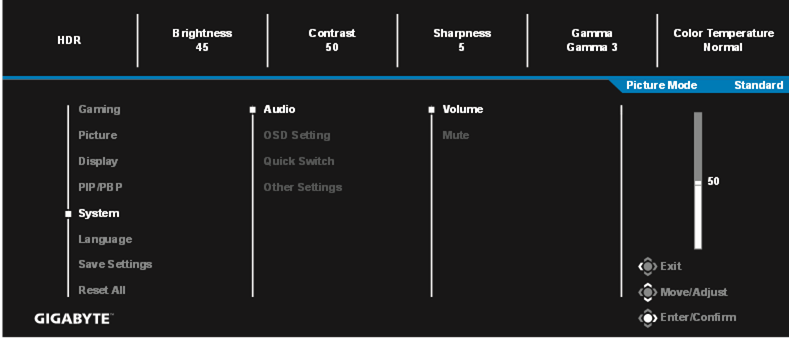
| Item | Description |
| Audio | Configure the audio settings.
|
| OSD Settings | Configure the on-screen display (OSD) menu related settings.
Note: To disable the OSD lock function, press the Control key. When the message appears on the screen, select Yes to confirm.  |
| Quick Switch | Assign the function of the hot keys. Available options: Aim Stabilizer, Black Equalizer, Low Blue Light, Volume, Input, Contrast, Brightness, and Picture Mode. The default setting of the hot keys as below: |
| Other Settings |
Note:
|
Language
Select an available language for the OSD menu.
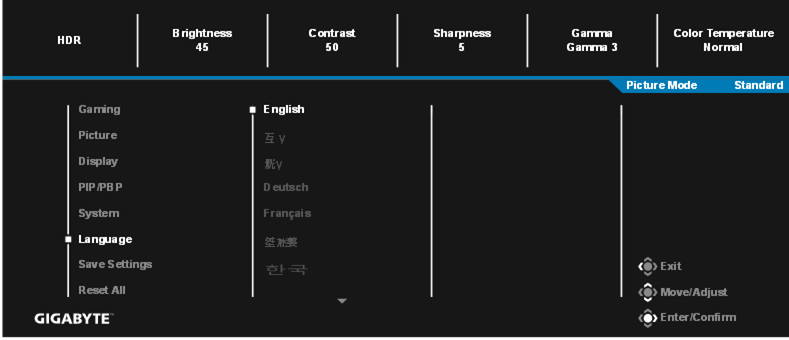
Save Settings
Set the personalized OSD configurations for Setting1, Setting2, or Setting3.
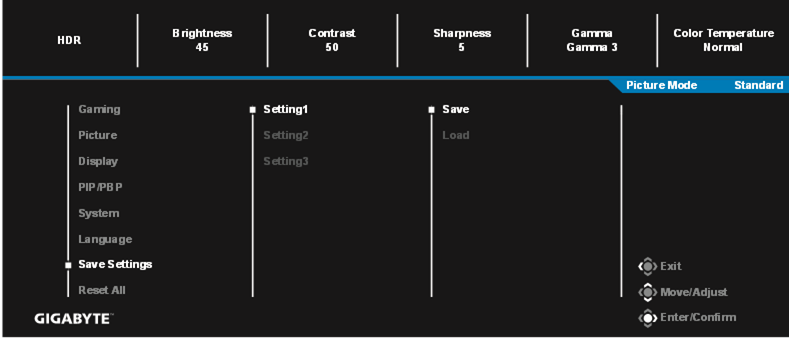
| Item | Description |
| Save | Save the customized settings. |
| Load | Load the saved settings. |
Reset All
Restore the monitor to its factory default settings.
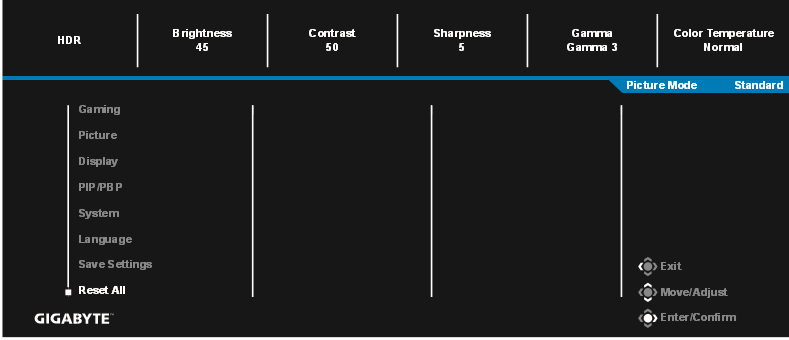
Supported Timing List
| Timing List | HDMI 2.0 | Display Port 1.2 / USB Type-C |
| 640x480@60Hz | ||
| 640x480@75Hz | ||
| 720x480@60Hz | ||
| 800x600@60Hz | ||
| 800x600@75Hz | ||
| 1024x768@60Hz | ||
| 1024x768@75Hz | ||
| 1280x720@60Hz | ||
| 1280x720@120Hz | ||
| 1920x1080@60Hz | ||
| 1920x1080@120Hz | ||
| 1920x1080@144Hz | ||
| 2560x1440@60Hz | ||
| 2560x1440@120Hz | ||
| 2560x1440@144Hz | ||
| 2560x1440@165Hz | ||
| 2560x1440@170Hz |
Troubleshooting
| Problem | Possible Solution(s) |
No power |
|
No image appears on the screen |
|
The image does not fill the entire screen |
|
The colors are distorted |
|
No sound or volume is low |
|
Note: If the problem persists, please contact our customer service for further assistance.
Setup Guide
To set up the Gigabyte M27Q P,
- Start by carefully unboxing the monitor and all included accessories.
- Connect the monitor to your computer or gaming console using either the HDMI or DisplayPort cable.
- Ensure that the cables are securely plugged into the correct ports on both the monitor and your device.
- Adjust the monitor's height, tilt, and swivel to your preferred viewing position. For optimal performance, enable AMD FreeSync Premium in your graphics card settings if using an AMD GPU.
- Finally, adjust the display settings on your device to match the monitor's capabilities, such as setting the refresh rate to 165Hz.
Basic Care
When the screen becomes dirty, do the following to clean the screen:
- Wipe the screen with your soft, lint-free cloth to remove any residual dust.
- Spray or apply the cleaning fluid onto a soft cloth. Then wipe the screen gently with the damp cloth.
Note:
- Make sure that the cloth is damp, but not wet.
- When wiping, avoid applying excessive pressure on the screen.
- Acidic or abrasive cleaners can damage the screen.
Notes on USB Charging
The following devices are not compatible with BC 1.2 of CDP mode. When the Hub is connected to a PC, these devices cannot be charged using the USB cable.
| Vendor | Device | PID/VID |
| Apple | IPad | PID_129A/VID_05AC |
| Samsung | Galaxy Tab2 10.1 | PID_6860/VID_04E8 |
| Samsung | GALAXY TabPro | PID_6860/VID_04E8 |
Gigabyte Gaming Monitor M27Q P SAFETY INFORMATION
Safety Precautions
Read through the following Safety Precautions before using the monitor.
- Only use the accessories that are provided with the monitor or that which are recommended by the manufacturer.
- Keep the plastic packaging bag for the product in a place that cannot be reached by children.
- Before connecting the monitor to the power outlet, make sure that the voltage rating of the power cable is compatible with the power specification in the country where you are located.
- The power cord plug must be connected to a properly wired and grounded power outlet.
- Do not touch the plug with wet hands, otherwise easily cause electric shock.
- Place the monitor in a stable and well-ventilated place.
- Do not place the monitor near any heat sources such as electric radiators or direct sunlight.
- The holes or openings on the monitor are for ventilation. Do not cover or block the ventilation holes with any objects.
- Do not use the monitor near water, drinks, or all types of liquids. Failure to do so may result in electric shock or damage to the monitor.
- Make sure to unplug the monitor from the power outlet before cleaning.
- As the screen surface is easy to be scratched, avoid touching the surface with any hard or sharp object.
- Use a soft lint-free cloth instead of a tissue to wipe the screen. You may use a glass cleaner to clean the monitor if required. However, never spray the cleaner directly onto the screen.
- Disconnect the power cable if the monitor is not being used for a long period of time.
- Do not attempt to disassemble or repair the monitor yourself.
Pros & Cons
Pros
- High-resolution QHD display for crisp visuals
- Fast 165Hz refresh rate and 0.5ms response time for smooth gaming
- AMD FreeSync Premium support to reduce screen tearing
- Ergonomic adjustments for comfort
- Sleek and minimalist design
Cons
- Limited HDR support compared to higher-end models
- No built-in speakers, requiring external audio solutions
- Potential for minor backlight bleed on VA panels
Customer Reviews
Customers have praised the Gigabyte M27Q P for its excellent gaming performance, vibrant colors, and ergonomic design. Many reviewers appreciate the fast refresh rate and low response time, which significantly enhance their gaming experience. However, some users have noted minor issues with backlight bleed and the lack of built-in speakers.
Common complaints include the monitor's limited HDR capabilities and the necessity for external audio solutions. Despite these minor drawbacks, the M27Q P remains a popular choice among gamers due to its overall performance and value.
Faqs
What is the refresh rate of the Gigabyte?
Does the M27Q P support AMD FreeSync?
What type of panel does the Gigabyte Gaming Monitor M27Q P use?
Can I adjust the height and tilt of the M27Q P?
What are the connectivity options available on the Gaming Monitor?
Is the Gigabyte suitable for console gaming?
How do I enable AMD FreeSync on the Gigabyte?
Is the Gigabyte compatible with NVIDIA GPUs?
Leave a Comment
